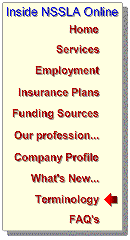 |
 |
Select the first letter of the word from the list
above to jump to appropriate section of the glossary. If
the term you are looking for starts with a digit or
symbol, choose the '#' link.
- Accent Reduction Therapy
- Therapy to modify speech sounds and vocal
characteristics or habits of spoken language
influenced by the geographical region and/or the
speaker's native language.
- Aphasia
- The adult-form of a language impairment. It may
be caused by stroke, brain injury
or severe illnesses resulting from neurological
injury.
-
- Apraxia of Speech
- A disturbance in the selection and sequencing of
sounds; it may be developmental or acquired.
-
- Attention Deficit Hyperactivity Disorder
(ADHD)
- A group of behaviors characterized by problems in
focusing and maintaining attention to tasks. Many
individuals with a diagnosis of ADHD exhibit
communication problems or learning disabilities.
-
- Augmentative and Alternative
Communication
- Methods of communicating for individuals who
cannot orally express themselves. Using assistive
technology, such as a communication board, one
can express his/her thoughts successfully.
-
- Autism
- A syndrome identified by a failure to develop
normal verbal and nonverbal communication skills
and reduced responsiveness to others within the
environment.
Bruxism
Teeth grinding, a habit which usually occurs at
night but which is related to malocclusion (poor
teeth relationship) and possibly swallowing or biting
problem.
-
- Cleft Palate
- A congenital anomaly affecting the speaking and
eating muscles.
-
- Cochlear Implant
- A device surgically placed on the head and
designed to improve hearing for those who could
not derive benefit from more traditional methods
of amplification such as hearing aids.
-
- Communication Disorder
- The breakdown or disruption in the exchange of
information and ideas.
- Dysarthria
- Problems within the motor aspects of speech
production secondary to brain injury.
-
- Dysgraphia
- Specific problem in written language secondary to
brain injury
- Dyslexia
- A specific language learning disability affecting
reading skills.
- Expressive Language Impairments
- Language problems that affect spontaneous and/or
structured verbal language.
- Feeding Therapy
- The training, re-training or development of the
muscles used for eating, drinking and swallowing
secondary to developmental/neurological
conditions.
- (empty)
- Hearing Impairment
- Any degree of hearing loss.
- Intelligibility
- The degree to which an individual's speech is
understood by others.
- Jargon
- Verbalizations of children approximately from 9
months to 18 months which contains syllables
- (empty)
-
- Language Delay/Disorder
- Difficulties in language comprehension,
formulation and/or language use. Like speech
disorders, language problems occurs in both children
and adults.
-
- Learning Disability
- Refers to a general term used to describe a
complex group of disorders evidenced by
significant difficulties in the acquisition and
use of listening, speaking, reading, writing,
reasoning, mathematical abilities, as well as
social skills.
- Myofunctional Therapy - see Tongue Thrust
- Neologism
- Speech behavior often exhibited by individuals
experiencing stroke or brain injury.
- Oral Motor Therapy
- Training of muscles use for speaking or eating
which are impaired or reduced secondary to
developmental/neurological conditions.
- Public Speaking/Professional or Executive
Speaking
- The refinement or improvement of an individual's
vocal projection, clarity and persuasive
communication skills (verbal and nonverbal).
Therapy is given on an elective basis for the
sole purpose of giving professional presentations
or for people who have verbally demanding jobs in
business and industry.
- (empty)
- Receptive Language Impairments
- Language problems that affect comprehension of
incoming language.
- Speech Disorder
- Difficulties producing sounds correctly. The
onset of this disorder is usually early childhood
and is usually called a Phonological or Articulation
Disorder. In adults, speech disorders usually are
a result of some type of brain injury.
-
- Stroke
- Is the major cause of aphasia. It is usually
caused by injury in a localized area of the
brain, traumatic brain injuries, brain tumors,
abscesses, infectious diseases, and degenerative
diseases.
-
- Stuttering
- Interruptions in the flow of speech. It is
characterized by repeating sounds, words, and/or
phrases. Onset of this disorder is usually
preschool and early adolescent. Adults may also
have this disorder.
-
- Swallowing Therapy
- The training of muscles for the oral, pharyngeal
and esophageal stages of ingesting liquids or
solids secondary to injury of these muscles.
-
- Tongue Thrust/Myofunctional
Therapy
- The condition and type of therapy which retrains
the lips, tongue and facial muscles to work
properly for correct speech and swallowing and to
improve the appearance of the oral-facial
muscles.
-
- Traumatic Brain Injury
- Injury sustained from the impact of a car
accident, fall, or other injury to the head.
- Unintelligibility
- The degree or measure to which a person cannot be
understood.
- Voice Disorders
- A problem in the perceptual quality of a person's
voice. An individual's voice may sound
"harsh," "hoarse,"
"lower/higher than usual pitch,"
"nasal" and/or "breathy."
Sometimes these problems are due to vocal nodules
or polyps.
- (empty)
- (empty)
- (empty)
- (empty)
- (empty)
|
|

